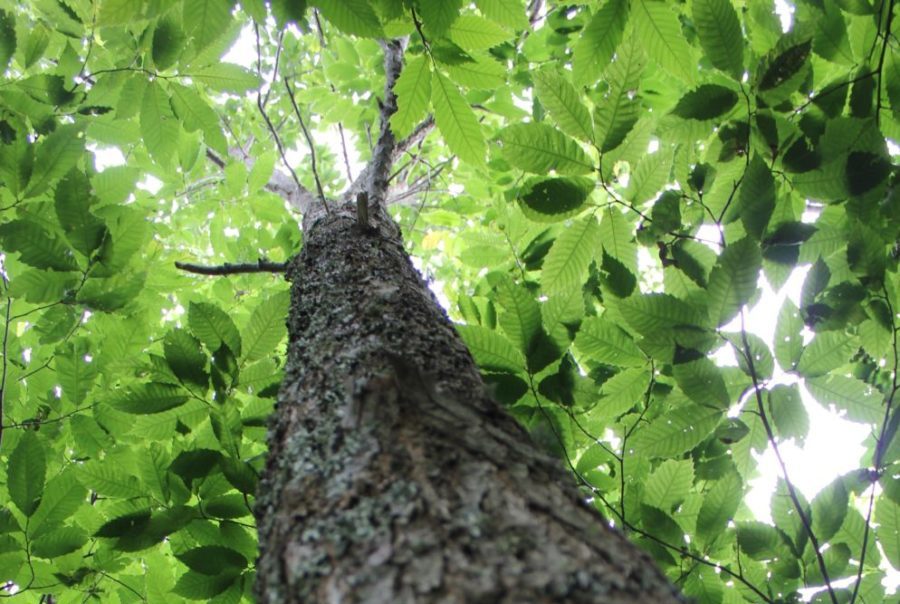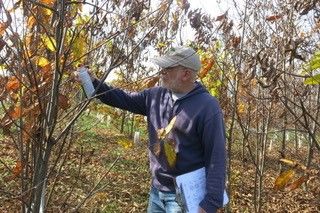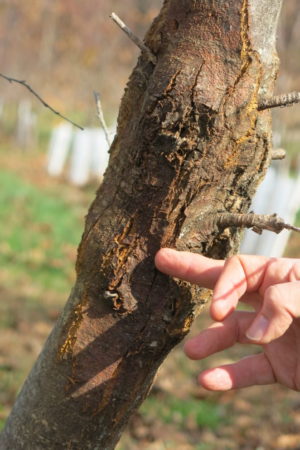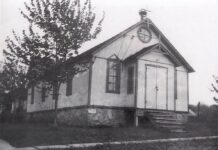
On an early fall day, orange spray can in hand, Bruce Levine weaves his way through an orchard of American chestnut trees in Sunshine, Md. — a short jog down a country road near the intersection of Georgia and New Hampshire avenues. It’s where Levine methodically examines trees for signs of blight and marks the sickliest for removal.
When in bloom, the male flowers of these trees look like long leggy whiteish pipe cleaners, with the female flowers emerging at their base as green spiky burs. As winter approaches, the burs will turn brown, dry out and eventually release the seeds inside.
Today, the American chestnut is functionally extinct. The trees were wiped out in a blight in the first half of the 20th century. But they once blanketed the East Coast, providing food, fuel and building materials across 200 million acres from Maine to Mississippi, and into the Ohio Valley. “The Christmas Song’s” chestnuts roasting on an open fire is a vestige of the trees’ omnipresence.
The trees in this 2-acre nursery known as WSSC-3, after its landlord, the Washington Suburban Sanitary Commission, are part of the attempt to resurrect the American chestnut. In this patch of Montgomery County, Levine is looking for a way to increase the chances of the trees’ survival.
“We’re breeding trees with a little Chinese chestnut in them,” he explains.
They’re about 1/16 Chinese, he says, with the Chinese chestnuts carrying resistance to cryphonectria parasitica, an invasive Asian fungus that first appeared on the American landscape in the late 1800s. Fifty years later, the invasion had nearly wiped out the 4 billion American chestnuts.
Levine says all of Montgomery County was part of the American chestnut native range, with the largest concentration in areas with higher elevation.
The oldest trees in the orchard were planted as seedlings a decade ago. New ones have been put in the ground each year, first in plots of 150 plants, one foot apart, and gradually at three feet, a distance that would give the saplings a better chance of survival.
“Right now, of the 6,000 to 7,000 planted, I estimate we still have about 1,100 seedlings there,” Levine says. “But it will take at least another five years to have maybe 50 unique individual trees that show decent resistance.”
Redwoods of the East
It’s hard to imagine Maryland’s landscape so replete with chestnuts. Called the Redwoods of the East, the chestnuts’ dominance was undeniable.
Among the tallest, largest and fastest growing, its hardwood was valued for furniture, barns and split-rail fences, railroad ties and pianos. Cherokee people used the nuts in cornmeal dough, and its sprouts to help heal sores and wounds.
They also provided a high-protein diet for wildlife and livestock, so abundant that “reports of chestnuts four inches deep on the forest floor were not uncommon in many parts of the Appalachian Mountains,” says Donald Davis, a research scholar, who has written extensively about American chestnuts.
They inspired much awe, Davis adds, evoking a memory from a ranger at Great Smoky Mountains National Park who discovered a hollow in a tree “so large that [an adult] could stand up in it. A man lost some stock during a snowstorm and later found them safe in a hollow chestnut tree,” the ranger said.
In ecological terms, “The devastation of the American chestnut by the chestnut blight represents one of the greatest recorded changes in natural plant population caused by an introduced organism,” says West Virginia University professor emeritus William MacDonald, who has studied its pathology for decades.
Its demise ended an American way of life, Davis writes. “With the death of the chestnut, an entire world did die, eliminating subsistence practices that had been viable in the Appalachian Mountains for more than four centuries.”
Remnant populations carry on because blight does not attack their root system, allowing new growth to sprout and mature into shrub-like trees that never reach the canopy. Eventually, they succumb either from blight or are out-competed in the forest. WSSC-3 is managed by the Maryland Chapter of The American Chestnut Foundation (TACF) that runs programs in 20 states, including eight orchards in Montgomery County.

TACF Chief Conservation Officer Sara Fitzsimmons helps equip field workers like Levine with the tools to fight off the fungal disease. “Our plan is three-fold: You have to conserve the native diversity of the remnant wild population. You have to find methods of incorporating resistance to the disease. You have to put them together, and then you put them back in the forest,” she says.
Fitzsimmons sees a place for the American chestnut on farmlands gone fallow and mines in need of remediation. She says the biggest challenge isn’t lack of land, but the time and money needed to defend the land from the massive deer population and invasive species.
New forest planting accounts for approximately 150 acres, not enough to make an ecological impact. “We need to start producing 1-to-2 million seedlings a year, and we’re currently establishing seed orchards to try to get to that level in the next ten to 20 years,” she says.
Good science and patience
Levine says in Maryland the annual cycle begins at the end of September when nuts are harvested and put into cold storage until spring when the seeds are planted.
“Once they grow large enough, they are inoculated with the blight fungus to test their resistance,” he says, pointing to a small hole where samples of blight had been inserted under the bark and wrapped with masking tape.
He follows a procedure proscribed by TACF called backcross breeding in which selected offspring of the first cross between Chinese and American chestnut are crossed with, or “back” to American chestnut in subsequent generations.
He says the process works, but has its limitations. “We now know, thanks to genetic sequence analysis, that the main reason is that there are too many genes involved in blight resistance to reliably capture them all in individual trees through backcross breeding,” he says. “Most of the genes we need are probably present in our breeding population, but not all concentrated in any single tree.”
Beginning in 2022 Maryland began crossing the state’s best trees with the best trees in Virginia. “The hope is that we will get higher levels of resistance,” he said. “It’s going to take a few years to sort this out. And, if the answer is no, it’s sort of back to the drawing board.”
“Science never works the way you set out, and you have to be flexible,” he adds.

Levine worked as a TACF volunteer for 20 years before he retired in 2016 from a career as a foreign service officer. Until late last year he was the Maryland chapter president.
He is currently working on a Ph.D. in plant science at the University of Maryland, developing a means to use a gene editing tool called CRISPR to efficiently manipulate the genome of the chestnut blight fungus.
“If you knock a gene out and the fungus grows well in a Petrie dish but not in the tree, you have found something that is important,” he said, noting the work takes a lot of trial and error.
In other efforts, TACF has partnered with the College of Environmental Science and Forestry (SUNY ESF) with a genetically engineered American chestnut called Darling 58. Studies show good results in the controlled experiments, finding enhanced resistance to blight using a single gene from wheat.
SUNY ESF has petitions before several federal agencies to apply unregulated status to the new strain. Fitzsimmons says the request is unprecedented, and would make the species the first genetically modified tree designed for release in the wild. She is encouraged by USDA’s draft review, which concludes that Darling 58 is unlikely to pose a plant pest risk and that the tree’s release is likely to have positive or similar benefits to that of planting other chestnuts. Final regulatory on deregulation may occur as early as spring 2023.
While Darling 58 would certainly be a game changer, Fitzsimmons says the work must continue on multiple fronts. “When you talk about something as big as disease resistance, you want as many tools as possible,” she says. “You make a more complicated puzzle that makes it harder for the disease to overcome in the long term.”
Fitzsimmons says gains for the American chestnut promote the overall health of the American forest. “You want the chestnut to get installed because we are going to face this challenge with more species. We need a template so that we can rescue [them] and have the diversity that our forested ecosystems need to continue to maintain themselves.”
Levine doesn’t expect to see any widescale return of the American chestnut in his lifetime. “Just because it takes a long time doesn’t mean that it is not worth doing,” he says. “I want these trees back in the forest.” !
Rosanne Skirble is a freelance writer in Silver Spring.




